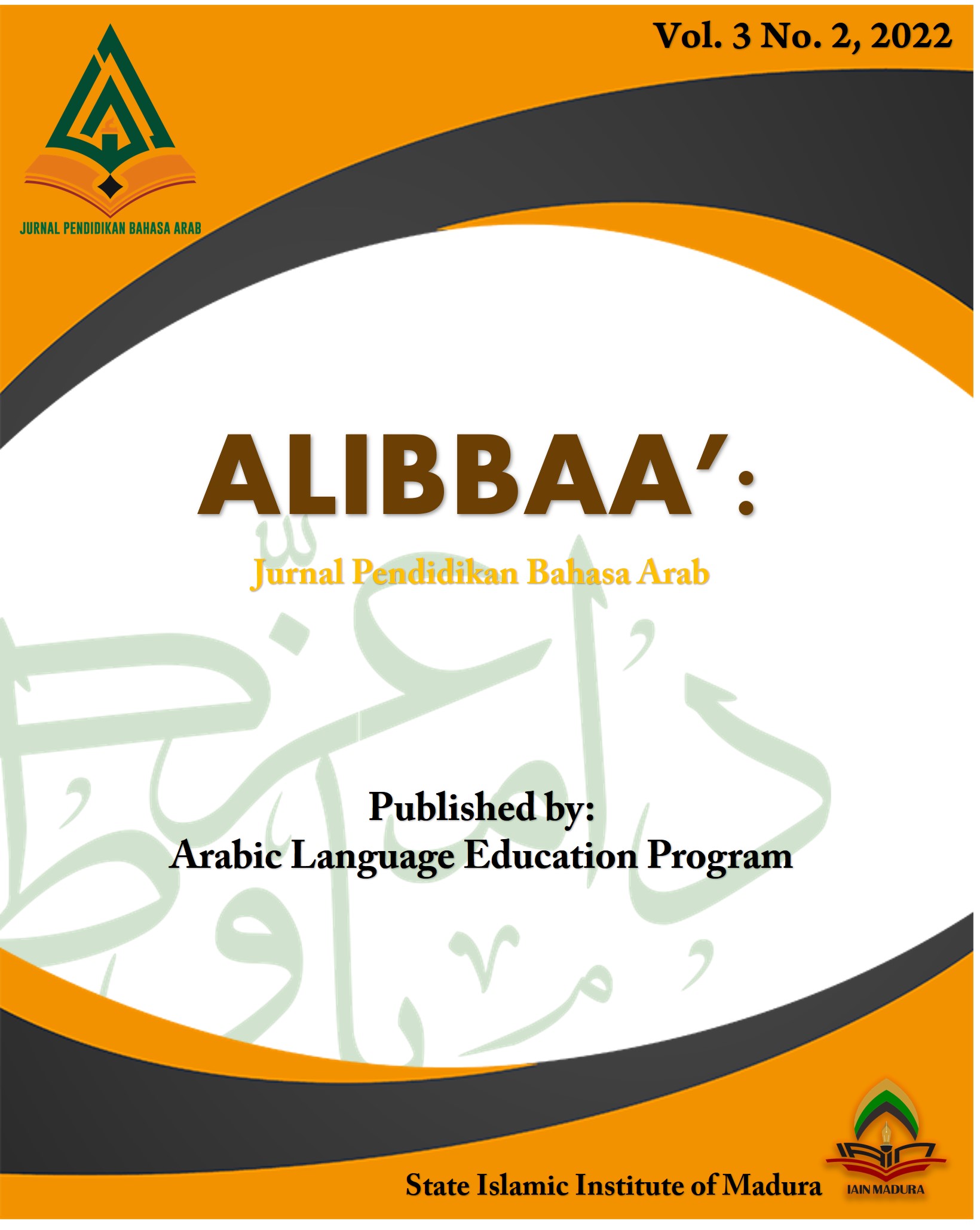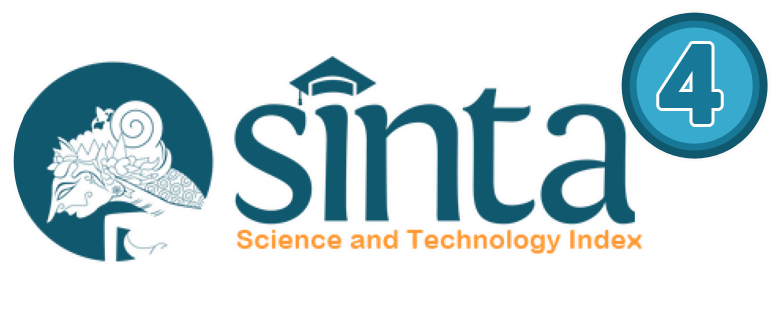Dialektologi Bahasa Arab Pada Komunitas Tutur Arab Lokal (Alumni Ponpes Di Sulawesi Tenggara)
 Abstract views: 381
,
Abstract views: 381
,
 pdf downloads: 662
pdf downloads: 662
Abstract
In this study, the authors describe and explain the various types of dialect insertions that occur when Arabic is spoken by PBA IAIN Kendari students. Data were collected through qualitative and descriptive research, and the results are described in detail. PBA students at the IAIN Kendari campus are motivated by several ethnic groups in Southeast Sulawesi, including the Tolaki tribe whose language has the dialect insertion of deela, mi, ji, pokoknya, pucat, nah. Also, the Butonese and Wolio tribes whose languages have local dialects insertion ee, mi, mo kae, kaasi, and garaa. Bugis language has inserts ki, ka, ja, and pale. The Kabaena and Moronene tribes insert local dialects, namely na awu, amaa, nde e and baa. The Muna tribe has a local dialect with the insertion of kunae. Fields inserted using local dialects often occur in both formal and informal contexts. The insertion of local dialects used in communicative languages results in the form of transcoding and code-mixing. Transcoding that occurs can be in the form of a single sentence or dialogue. The implications of this research are expected to contribute to the use of Arabic which is still considered by many people to be difficult to use and understand until now. By inserting a local dialect, the use of Arabic will be easy to use and understand in the form of daily communication.Dialectology, Arabic, Code Mixing
Downloads
References
Agustina, abdul & leonie, chaer. Sosiolinguistik perkenalan awal. Jakarta: rineka cipta, 2010.
Al-khulli, muhammad ali. A dictionary of theoretical linguistics, english arabic. Cetakan pertama. Beirut: libraire du luban, 1982.
Aviah, “Alih Kode, Campur Kode Dan Perubahan Makna Pada Integrasi Bahasa Arab Dalam Bahasa Indonesia Di Film Sang Kiai (Analisis Sosiolinguistik),” Lisanul Arab: Journal of Arabic Learning and Teaching, Vol. 8 No. 2, 2019: 135-139. https://journal.unnes.ac.id/sju/index.php/laa/article/view/36169.
Ayatrohaedi. Pedoman praktis: penelitian dialektologi. Jakarta: pusat pembinaan dan pengembangan bahasa depdikbud., 2002.
Cahyono. Kristal-kristal ilmu bahasa. Surabaya: airlangga university press, 1995.
Chaer, abdul. Linguistik umum. Jakarta: rieneka cipta, 2007.
———. Lingusitik umum edisi revisi. Jakarta: pt. Rineka cipta, 2012.
Fasold, ralph w. The sociolinguistics of society. Oxford: basil blackwell, 1984.
Fithriyahni, azizah. “bahasa arab fusha dan ‘ammiyah serta cakupan penggunaannya,” 2018.
J. Moeloeng, lexy. Metodologi penelitian kualitatif. Bandung: rosda karya, 2015.
Kemdikbud, pengelola web. “badan bahasa petakan 652 bahasa daerah di indonesia,” 2018. https://www.kemdikbud.go.id/main/blog/2018/07/badan-bahasa-petakan-652-bahasa-daerah-di-indonesia.
Kurniasih, dwi, dan siti aminataz zuhriyah. “alih kode dan campur kode di pondok pesantren mahasiswa darussalam.” Indonesian language education and literature, Vol. 3, No. 1, 2017: 53. https://doi.org/10.24235/ileal.v3i1.1521.
Nugroho, adi. “alih kode dan campur kode pada komunikasi guru-siswa di sma negeri 1 wonosari klaten.” Universitas negeri yogyakarta, 2011.
Pangaribuan, tangson r. “hubungan variasi bahasa dengan kelompok sosial dan pemakaian bahasa,” t.t., 7.
Purwaningrum, prapti wigati. “variasi dialek dalam budaya jawa di kabupaten tangerang (sebuah kajian dialektologi),” 2021, 7.
Putra, wahyu hanafi. “Relativitas Ragam ‘Āmiyyah Dan Bahasa Daerah Di Pondok Modern.” Tsaqofiya: Jurnal Pendidikan Bahasa Arab Iain Ponorogo, Vol. 2, No. 2, 2020: 129–147. https://doi.org/10.21154/tsaqofiya.v2i2.18.
Sugiyono. Metode penelitian pendidikan pendekatan kuantitatif, kualitatif r&d, 2017.
Tiawaldi, adit, dan muhbib abdul wahab. “Perkembangan Bahasa Arab Modern Dalam Perspektif Sintaksis Dan Semantik Pada Majalah Aljazeera.” Arabiyat: Jurnal Pendidikan Bahasa Arab Dan Kebahasaaraban, Vol. 4, No. 1, 2017: 1-19. https://doi.org/10.15408/a.v4i1.5328.
Wahab, Laode Abdul. “Pilihan Kode Dalam Ranah Sosial Pada Masyarakat Keturunan Arab Empang,” 2012: 21.
Zahra, alya, Dan Rika Astari. “Variasi Bahasa Arab Pada Penutur Bahasa Malta Dalam Tataran Fonologi.” 'Ajamiy: Jurnal Bahasa Dan Sastra Arab, Vol. 10, No. 2, 2021: 436. https://doi.org/10.31314/ajamiy.10.2.436-457.2021.
Authors who publish with this journal agree to the following terms:
a. Authors retain copyright and grant the journal right of first publication with the work simultaneously licensed under a Creative Commons Attribution License that allows others to share the work with an acknowledgement of the work's authorship and initial publication in this journal.
b. Authors are able to enter into separate, additional contractual arrangements for the non-exclusive distribution of the journal's published version of the work (e.g., post it to an institutional repository or publish it in a book), with an acknowledgement of its initial publication in this journal.
c. Authors are permitted and encouraged to post their work online (e.g., in institutional repositories or on their website) prior to and during the submission process, as it can lead to productive exchanges, as well as earlier and greater citation of published work (See The Effect of Open Access).
Alibbaa': Jurnal Pendidikan Bahasa Arab have CC-BY-SA or an equivalent license as the optimal license for the publication, distribution, use, and reuse of scholarly work.
In developing strategy and setting priorities, Alibbaa': Jurnal Pendidikan Bahasa Arab recognize that free access is better than priced access, libre access is better than free access, and libre under CC-BY-SA or the equivalent is better than libre under more restrictive open licenses. We should achieve what we can when we can. We should not delay achieving free in order to achieve libre, and we should not stop with free when we can achieve libre.

Alibbaa': Jurnal Pendidikan Bahasa Arab is licensed under a Creative Commons Attribution 4.0 International License
You are free to:
- Share — copy and redistribute the material in any medium or format
- Adapt — remix, transform, and build upon the material for any purpose, even commercially.
- The licensor cannot revoke these freedoms as long as you follow the license terms.











